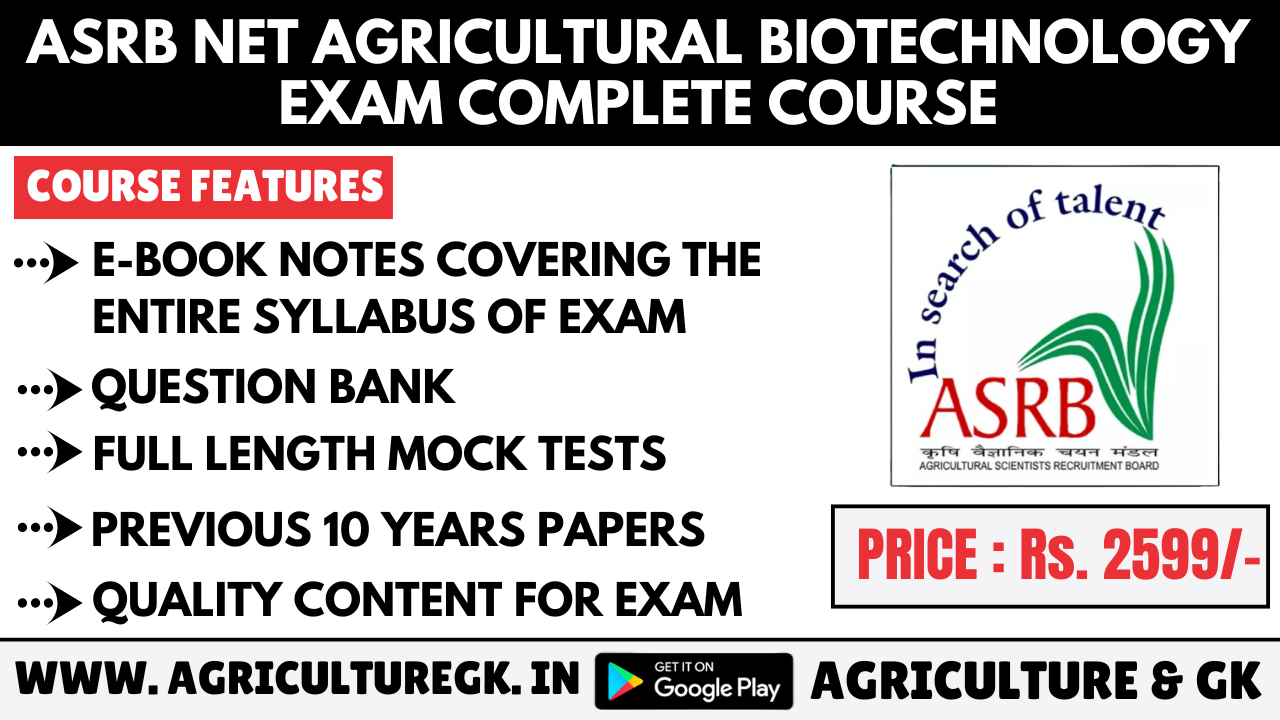ASRB NET Agricultural Biotechnology Exam Complete Course
Validity : 12 Months
- Complete Study Material as Per Syllabus
- Printable Ebooks
- Test Series Based on Exam Pattern
- Previous 10 Year Papers
- Call Us - 9473826765

₹2,599 ₹15,00083% off
Description
ICAR ARS NET Exam Syllabus for Agricultural Biotechnology
Unit 1: Cell Structure and Function
Prokaryotic and eukaryotic cell architecture, Cell wall, plasma membrane, Structure and function of cell organelles: vacuoles, mitochondria, plastids, golgi apparatus, ER, peroxisomes, glyoxisomes. Cell division, regulation of cell cycle, Protein secretion and targeting, Cell division, growth and differentiation.
Unit 2: Biomolecules and Metabolism
Structure and function of carbohydrates, lipids, proteins and nucleic acids, Synthesis of carbohydrate, glycolysis, HMP, Citric acid cycle and metabolic regulation, Oxidative phosphorylation and substrate level phosphorylation, Vitamins, plant hormones. Functional molecules, antioxidants, nutrient precursor, HSPs, anti-viral compounds.
Unit 3: Enzymology
Enzymes, structure conformation, classification, assay, isolation, purification and characterization, catalytic specificity, mechanism of action, active site, regulation of enzyme activity.
Unit 4: Molecular Genetics
Concept of gene, Prokaryotes as genetic system, Prokaryotic and eukaryotic chromosomes, methods of gene isolation and identification, Split genes, overlapping genes and pseudo genes, Organization of prokaryotic and eukaryotic genes and genomes including operan, exon, intron, enhancer promoter sequences and other regulatory elements. Mutation spontaneous, induced and site-directed, recombination in bacteria, fungi and viruses, transformation, transduction, conjugation, transposable elements and transposition.
Unit 5: Gene Expression
Expression of genetic information, operon concept, Transcription -mechanism of transcription in prokaryotes and eukaryotes, transcription unit, regulatory sequences and enhancers, activators, repressors, co-activators, Co-repressors in prokaryotes and eukaryotes, inducible genes and promoters, Transcription factors post transcriptional modification and protein transport, DNA-protein interaction, Genetic code. Mechanism of translation and its control, post translational modifications.
Unit 6: Molecular Biology Techniques
Isolation and purification of nucleic acids. Nucleic acids hybridization: Southern, northern and western blotting hybridization. Immune response monoclonal and polyclonal antibodies and ELISA, DNA sequencing. Construction and screening of genomic and c-DNA libraries. Gel electrophoretic techniques. Polymerase chain reaction, RT-PCR, QRT-PCR spectroscopy, ultracentrifugation, chromatography, FISH, RIA etc.
Unit 7: Gene Cloning
Restriction enzymes and their uses. Salient features and uses of most commonly used vectors i.e. plasmids, bacteriophages, phagmids, cosmids, BACs, PACs and YACs, binary vectors, expression vectors. Gene cloning and sub-cloning strategies, chromosome walking, genetic transformation, Risk assessment and IPR.
Unit 8: Molecular Biology
Ribosome structure and function. Protein biosynthesis in prokaryotes and ekaryotes. Post- translational modification. Gene regulation, RNA processing and Post-transcriptional modifications. Bioprospecting, biofortification, gene pryrimiding and gene fusion, ribozyme technology.
Unit 9: Plant Molecular Biology
Photoregulation and phytochrome regulation of nuclear and chloroplastic gene expression. photosynthesis, C3& C4 cycle and photorespiration; Molecular mechanism of nitrogen fixation. Molecular biology of various stresses, viz. abiotic stresses like drought, salt, heavy metals and temperature; and biotic stresses like bacterial, fungal and viral diseases. Signal transduction and its molecular basis, molecular mechanism of plant hormone action, mitochondrial control of fertility, structure, organization and regulation of nuclear gene concerning storage proteins and starch synthesis.
Unit 10: Tissue Culture
Basic techniques in cell culture and somatic cell genetics. Clonal propagation, Concept of cellular totipotency. Another culture, somaclonal and gametoclonal variations. Hybrid embryo culture and embryo rescue, somatic hybridization and cybridization. Application of tissue culture in crop improvement. Secondary metabolite production. In vitro, mutagenesis, cryopreservation and plant tissue culture repository.
Unit 11: Plant Genetic Engineering
Isolation of genes of economic importance. Gene constructs for tissue-specific expression. Different methods of gene transfer to plants, viz. direct and vector mediated. Molecular analysis of transformants. Potential applications of plant genetic engineering for crop improvement, i.e. insect-pest resistance (insect, viral, fungal and bacterial disease resistance), abiotic stress resistance, herbicide resistance, storage protein quality, increasing shelf-life, oil quality, Current status of transgenics, bio-safety norms and controlled field trials and release of transgenics (GMOs).
Unit 12: Molecular Markers and Genomics
DNA molecular markers: Principles, type and applications; restriction fragment length polymorphism (RFLP), amplified fragment length polymorphism (AFLP), randomly amplified polymorphic DNA sequences (RAPD), Simple sequence repeats (SSR), Single nucleotide polymorphism (SNP), Structural and functional genomics, gene mapping, genome mapping, gene tagging, transcriptomics, ionomics, metabolomics and proteomics, comparative genomics and application of genomics.
FAQ's About Course :
1. Can I Print PDF Files in this course?
Ans : Yes, PDF files are printable.
Note: This is a PDF course, No hardcopy will be sent to your address in this package.
If you have additional queries then please contact us on whatsapp : 9473826765.
PDF Language : English
Demo Videos



